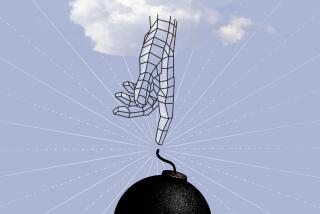The Dreams of Daedalus : THE FULLNESS OF WINGS The Making of a New Daedalus <i> by Gary Dorsey (Viking: $19.95; 342 pp., illustrated; 0-607-82444-5) </i>
- Share via
On April 24, 1988, a Greek athlete pedaled a super-lightweight airplane 70 miles across the Aegean Sea from Crete to Santorini in the longest human-powered flight in history. The fragile craft disintegrated at its destination and, similarly, the crew that launched it scattered like broken glass.
Gary Dorsey reconstructs both for us in a narrative remarkable for its insights as well as its omissions.
The builders of the Daedalus airplane produced a legacy of science and technology, of art and craftsmanship, of human physiology and endurance. Inevitably, someone else will do even more with even less, will fly farther or faster or higher. But that is not the focus here. This is not a book about flying or science or athletics.
This is about discovery and motivation, human stuff: how a group of students and engineers at Massachusetts Institute of Technology were gradually and inexorably drawn into a project that would assume proportions greater than the sum of its participants.
John Langford, the project leader, is in his senior year at MIT when he overhears a telephone conversation about an airplane that nobody wants. It was designed for human-powered flight but would not fly. While “John thought the notion of human-powered flight was particularly insipid,” Dorsey writes, he wanted the plane for his rocket club to fly as a model. Langford and his buddies would use real engines to power it.
And so they did, but still the stubborn BURD (Biplane Ultralight Research Device) would not fly. What a waste of time! The BURD had been built as a laboratory project at MIT, and the rocket club found it terribly flawed. It was all science and no engineering, a kludge, they called it.
This was nature’s gauntlet thrown down, a challenge that led Langford and his friends headlong into the human-powered flight business. But it was more than a challenge of physics; it was a competition with authority. Scholars had designed this failure, but pure engineering could triumph over scholarship.
At that time, another ultra-light-aircraft pioneer, Paul MacCready, had yet to capture the Kremer Prize for crossing the English Channel with his Gossamer Albatross. Langford propositioned MIT for $2,500 to build “the first in a series of crafts,” which might attempt the channel crossing and win the prize.
Langford and his friends, while not planning for an immediate channel crossing, nevertheless built a successful airplane and proved their engineering point. But that was only the beginning for the MIT group. Although MacCready crossed the channel first, MIT later beat out MacCready in another Kremer competition. The inference drawn from Dorsey’s account, however, is that prizes were secondary. There was something more basic at work here.
After their initial success, Langford and his friends took legitimate jobs in the aerospace industry. After all, they’d finished at a prestigious school and were expected to pursue prestigious careers at prestigious companies. But they could not; they were drawn back to earlier dreams, a more creative environment.
All of this is but prologue to the Daedalus project, whose aim was to re-create--or rewrite--the myth of Daedalus and his son Icarus fleeing a labyrinth prison, borne on fragile wings over the Aegean.
As the Daedalus team works toward its goal, Dorsey’s report becomes laden with conflict. There were doubts, worries, petty jealousies, nervous encounters with the press, failures, crashes. The story bogs down here but gains credibility. This does not have the scent of an “authorized” report.
The trip to Crete, the anxious wait for perfect weather and the conflicts that mount as time runs short--these amount to an epilogue of endeavor rooted in children’s fantasy.
Dorsey’s work is valuable for its insight into the personalities involved. There is a good deal of biography here--what these adult engineers and scientists did as children and college students, what excited them, what inspired them. Dorsey is a journalist, and this is good reporting. We see how the players are drawn into the project; we see pride at work, ingenuity, determination, skill, teamwork, patience, love, strife.
Langford is portrayed at first as an eager understudy of his slightly elder peers and later as a relentless taskmaster who alienated his best friends. But most of all, he and his colleagues are seen as dreamers.
In an afterword, Langford writes, “it was a disappointment to come of age in a time when Jimmy Carter specifically offered ‘no new dreams’ in his inaugural, and when the inspiration offered by Ronald Reagan was to ‘just say no.’ The development of the Daedalus project probably drew at least part of its energy from this disappointment.”
Part of its energy, maybe. Dorsey calls the Daedalus crew “renegades” and “radicals” attached to a nucleus of MIT rocket buffs and model builders, also renegades and radicals. Clearly these are terms of admiration, but Dorsey falls short of revealing the difference between the dreams of children and of adult “renegades.”
The only ones capable of a true understanding of this kind of dreaming may be the dreamers themselves. But there are hints here, and therein lies the charm of this tale.
One can’t help but wish, though, that MacCready had been given equal--or at least better--billing. His was a different kind of team in a different setting. But he was a winner in the same game and no doubt a powerful dreamer of the same, mysterious ilk.






